Seek Blessings At Vijaya Vittala Temple An Experience To Remember In 2026
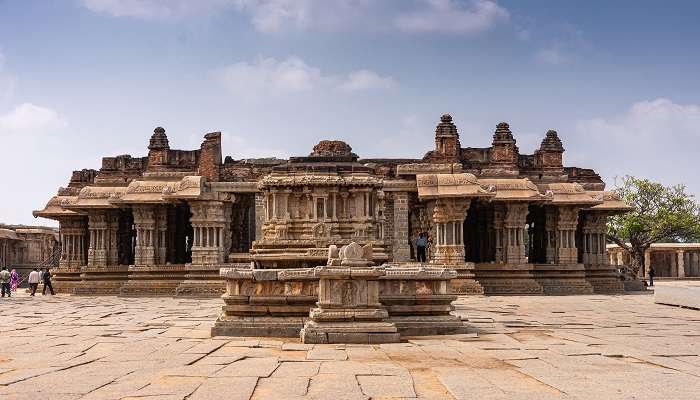
The Vijaya Vittala Temple in Hampi is an ancient monument well-known for its exceptional architecture and unmatched craftsmanship. It is considered one of the largest and most famous structures in Hampi. The temple is located in the northeastern part of Hampi, near the banks of the Tungabhadra River. The iconic temple has impressive stone structures, such as the incomparable stone chariot and the fascinating musical pillars. This predominant monument of Hampi is a major attraction of the ruined town and is a must-see for visitors and tourists. We’ve compiled a list of all you need to know about Vijaya Vittala Temple on your next trip to Hampi.
About Vijaya Vittala Temple
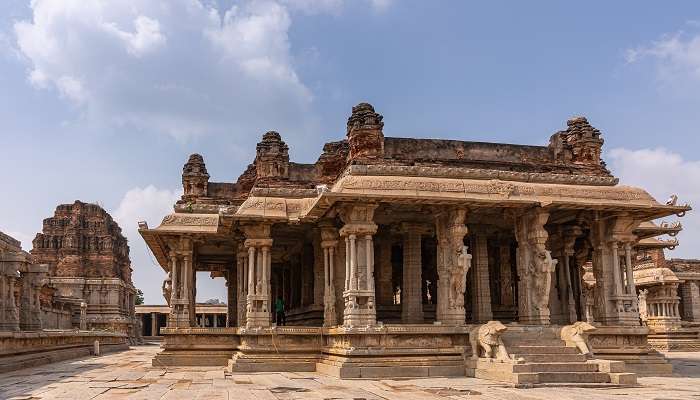
At 9 km (or 2.3 km by walk) from Hampi Bus Stand and 5.5 km from Kamalapura Bus Stand, Vittala Temple is an ancient monument on Hampi’s southern bank of the Tungabhadra River. The Vijaya Vittala Temple, or Vittala Temple, is Hampi’s most famous and popular tourist place. This temple is renowned for its Stone Chariot and Musical Pillars. It was built around the 15th century AD during the reign of King Devaraya II (1422 – 1446 AD).
Several portions of the temple were expanded and enhanced during the reign of Krishnadevaraya (1509 – 1529 AD). This temple is dedicated to Lord Vishnu in the form of Vittala. The temple is well-known for its exceptional architecture and unmatched craftsmanship. This predominant monument of Hampi is a major attraction and a must-see for visitors.
Must Read: Hotels In Hampi For Family
Architecture
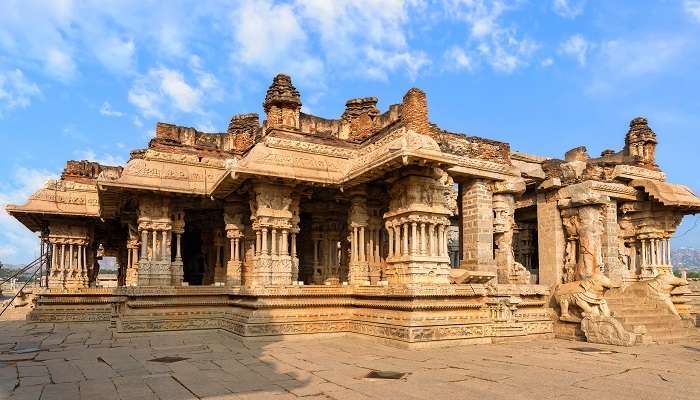
The Vittala Temple is presumed to be the grandest of all temples and monuments in Hampi. It exemplifies the immense creativity and architectural excellence possessed by the sculptors and artisans of the Vijayanagara era. The Vittala temple was built using the Dravidian style of architecture. It has traits and features characteristic of typical South Indian temple architecture. Its elaborate and artistic carvings and magnificent architecture are unmatched by any other structure found in Hampi. It is believed that the temple’s central shrine originally had one enclosed Mantapa.
An open Mantapa was added to it in the year 1554 A.D. The temple complex is a sprawling area surrounded by high compound walls and three towering gateways. The temple complex has many halls, shrines, and pavilions. Each of these structures is made of stone, and each structure is a beauty in itself. Notable among these structures are the shrine of the Goddess (also known as Devi shrine), Maha Mantapa or main hall (also known as Sabha Mantapa or congregation hall), Ranga Mantapa, Kalyana Mantapa (marriage hall), Utsava Mantapa (festival hall), and the famous Stone Chariot.
Inside The Vijaya Vittala Temple
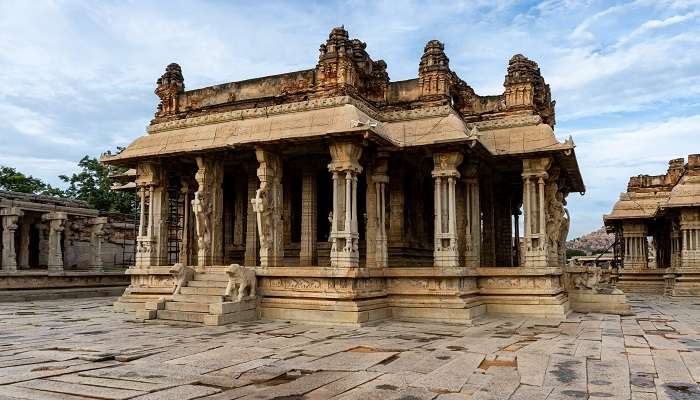
The Vittala Temple is regarded as the most ornate of the Vijayanagara temples. The temple comprises several attractions that make it a must-visit structure for tourists. It is the most visited monument in Hampi and the most photographed monument in Hampi. Among the main attractions of the Vittala Temple is The Maha Mantapa, or the main hall of the Vittala Temple, which is situated in the inner courtyard of the temple complex. It is a structure of immense beauty located in a highly ornate base. The base is decorated with carvings of warriors, horses, swans, and other ornaments.
- The Maha Mantapa comprises four smaller halls. The steps on the eastern side of the Maha Mantapa are decorated with elephant balustrades. There are forty pillars lining the facade of the temple. Each of these pillars has a height of 10 feet. The central part of the Maha Mantapa has sixteen intricately decorated pillars with beautiful sculptures of Narasimha and Yali. This set of sixteen pillars forms a rectangular court. The ceiling of the Maha Mantapa is a richly designed structure. The beautifully sculpted ornate pillars of the Maha Mantapa exemplify the splendour of this magnificent temple.
- The Vittala Temple Complex has the richly sculpted Stone Chariot, which is considered the most stunning architecture of the Vijayanagara kingdom. The Stone Chariot or Ratha stands in the courtyard of the temple. It is one of the three famous stone chariots in India. The other two chariots are in Konark (Odisha) and Mahabalipuram (Tamil Nadu). The Stone Chariot of Vittala Temple is a shrine designed as an ornamental chariot. The shrine is dedicated to Garuda and has an image of Garuda enshrined in the sanctum. As per Hindu mythology, Garuda is the carrier of Lord Vishnu.
- The Ranga Mantapa is one of the main attractions of the Vittala Temple. The large mandapa is renowned for its 56 musical pillars. These musical pillars are also known as SAREGAMA pillars, indicating the musical notes they emit. The musical notes emanate when the pillars are tapped gently. There is a set of primary and several minor pillars inside the Mantapa. Each central pillar provides support to the ceiling of the Ranga Mantapa. The main pillars are designed as musical instruments. Seven minor pillars surround every central pillar. These seven pillars emit seven different musical notes from the representative musical instruments. The notes from these pillars vary in sound quality depending on whether the instrument is a percussion, string or wind.
Suggested Read: Historical Places In Karnataka
How To Reach
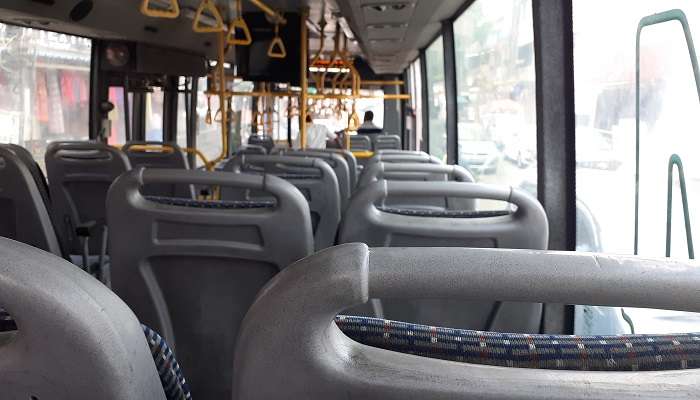
The Vittala Temple in Hampi is situated at the end of the ruined Vittala Bazaar. The place can be easily reached by vehicles from all parts of Hampi.
By Air:
Hampi cannot be reached directly by flight as the ruined town has no airport. Ballari (Bellary) is the town closest to an airport, around 64 km from Hampi. Visitors can reach Bellary by taking a flight and proceeding to Hampi using local transport.
By Rail:
Hampi does not have a railway station. The nearest railway station is in the city of Hospet. The Hospet Junction Railway Station is connected to several other towns and cities of Karnataka using regular trains. Hospet is situated around 10 km from Hampi. One of the easiest ways to reach Hampi from Hospet is to board a bus. There are a few other means of local transport.
By Road:
Hampi has a good road network and is connected to many towns and cities in Karnataka by this network. Many government and private buses travel between Hampi and several towns and cities in the state. Visitors can also hire private cars, cabs, or other vehicles from big cities like Bengaluru (Bangalore) or Mysuru (Mysore) to travel to Hampi.
Further Read: Mumbai To Hampi Road Trip
Now that you have a list of things to remember for your next vacation to see the beautiful Vijaya Vittala Temple make sure you plan your trip to Karnataka to these fabulous spots for the experience of a lifetime. Don’t miss out on these opportunities, and book your tickets now!
For our editorial codes of conduct and copyright disclaimer, please click here.
Cover Image Source: Shutterstock
Frequently Asked Questions About Vijaya Vittala Temple
Where is Vijaya Vittala Temple located?
Vijaya Vittala Temple is located in Hampi, Karnataka, India. It's part of the UNESCO World Heritage Site of the Group of Monuments at Hampi, which is located on the banks of the Tungabhadra River.
What is the most famous feature of the Vijaya Vittala temple?
The temple is renowned for its iconic Stone Chariot, a massive sculpture of a chariot standing in the courtyard. This intricately carved structure is one of the most recognisable symbols of Hampi.
When was Vijaya Vittala Temple built?
The temple was constructed in the 16th century during the reign of King Krishnadevaraya, one of the most famous rulers of the Vijayanagara Empire.
What architectural style does the Vijaya Vittala temple showcase?
Vijaya Vittala Temple exemplifies Dravidian architecture with its elaborate carvings, ornate pillars, and expansive courtyard. It's particularly famous for its musical pillars that produce different musical notes when struck.
What are the visiting hours and best time to visit Vijaya Vittala Temple?
The temple is typically open from sunrise to sunset. The best time to visit is during the cooler months, from October to February. Early morning or late afternoon visits offer the best lighting for photography and a more comfortable experience.
People Also Read:
Devalsari Temple Lingaraja Temple Hampi Temples

Unveil the hidden treasures of the globe and turn every travel dream into reality. As a Content Writer, I am passionate enough to craft stories from ancient wonders to modern marvels. My words paint the picture-perfect itinerary for unforgettable experiences. Let my words be your trusted guide to immerse in the diverse culture and discover the beauty of the unknown.











